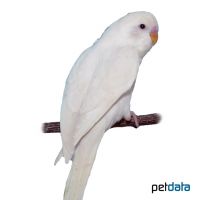Budgerigar White (Melopsittacus undulatus)
| Budgerigar White Melopsittacus undulatus | |
|---|---|
| Name | Budgerigar White |
| Name Lat. | Melopsittacus undulatus |
| Family | Parrots |
| Family lat. | Psittacidae |
| Order | Parrots |
| Order lat. | Psittaciformes |
| Origin | Australia |
| Climate | Subtropical - tropical |
| Diet | Budgie seed, plant matter, fruits |
| Keeping | Pair, group |
| Care Level | Easy |
| Reproduction | Cavity nest |
| Life Span | 10-12 years |
| Protection | No |
| Metric Units | |
| Size | 18 cm |
| Temperature | Room temperature |
| Housing | 100 x 50 x 50 cm |
| US Units | |
| Size | 7" |
| Temperature | Room temperature |
| Housing | 40" x 20" x 20" |
Distribution and habitat
Budgerigars are widespread in the steppes and dry savannas of Australia, where they live in huge flocks. The first budgerigars came to Europe in 1840. Since the export ban in 1960, they are only available as offspring and are bred in many color mutations.
Cage size
The minimum cage size is 120 x 60 x 100 cm (L x W x H) for a pair. The cage must be placed at a height of at least 80 cm (except aviaries) in a bright, draught-free and quiet place and should have cross-wiring or mesh. Keeping in an indoor aviary (e.g. 200 x 100 x 200 cm) is preferable. Birds kept in a cage should be given daily controlled indoor free flight without danger after a period of acclimation.
Maintenance
The floor must be covered with sand, shavings of untreated wood or similar material and cleaned once a week if possible. At least 2 perches made of wood or branches of different thickness and height are to be installed in such a way that the longest possible flight path is created. In addition to a bathing facility (bath house), they need hiding places (sleeping boxes, sleeping baskets) as well as climbing and occupation material, such as rings, ropes, ladders and natural branches that are harmless to health. They should be kept at room temperature, between 18 and 25 °C.
Diet
The species-specific feed offer consists of mixed seeds, available in specialized trade as "budgie feed" in premium quality, supplemented with foxtail millet, vitamin crackers, green feed (dandelion, chickweed, green panicle millet), fruit (apples, pears, etc.), organic lettuce, grass seeds and occasionally insect feed (wheat or chickweed).), organic lettuce, grass seed, occasional insect food and, especially for raising young, germinated seed (wheat or millet) and hard-boiled hen's egg mixed with egg feed. They need grit, cuttlefish and vitamin lime as digestive aids. Water must always be available in birdbaths or in stable, open containers. Feed and water must be offered fresh daily, and the containers must be cleaned beforehand.
A varied diet promotes health and prevents deficiency symptoms.
Reproduction and breeding
In young birds, the males can be recognized by the pink beak wax skin, in females the nostrils are white-rimmed. In adults, the males have a blue, females a brownish beak wax skin.
They breed in transverse or vertical nest boxes. A clutch consists of 4-6 eggs on average, the brood duration is 18 days. Soft sawdust is suitable as nest box bedding. The breeding season is year-round, depending on biological conditions. However, no more than 2-3 broods should be allowed annually. Young birds should be raised so that they are species-specific.
Important
Budgies should be provided with a leg ring.
They must not be kept in a round cage. For keeping in a group, an aviary is required.
When kept in an outdoor aviary (at least 1.70 m high), they also need a heated shelter of at least 0.5 m² floor space, which can be visited by the birds at any time. The temperature in the shelter must not fall below 5 °C and the furnishings must correspond to those of cage keeping. 
They may be kept only in pairs or in a group. Socialization with other peaceful bird species, such as cockatiels or finches is well possible. In rooms, including shelters, adequate daylight or flicker-free artificial light (stroboscopic effect) corresponding to daylight should be provided. The lighting duration shall be 8-12 hours per day and the natural day-night rhythm shall be observed. Adequate indoor climate shall be provided. The health condition of the birds shall be checked daily.
Further literature can be found in your pet store.
References
Text: Othmar Sieberer; Image: petdata
Source: BMEL (1995): Tierschutzgutachten - Mindestanforderungen an die Haltung von Papageien; BMEL-Haustier-Berater.de; ARNDT (1997): Lexikon der Papageien, Arndt Verlag; GRUMMT & STREHLOW (2009): Zootierhaltung - Tiere in menschlicher Obhut: Vögel, Verlag Harri Deutsch
- Gemäß § 21 Abs. 5 Tierschutzgesetz idgF
